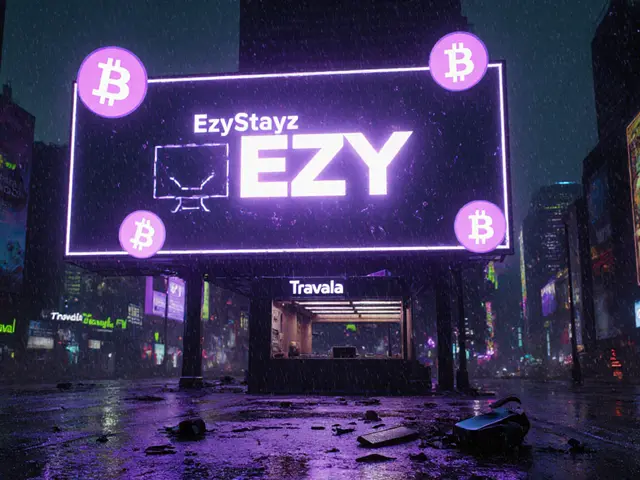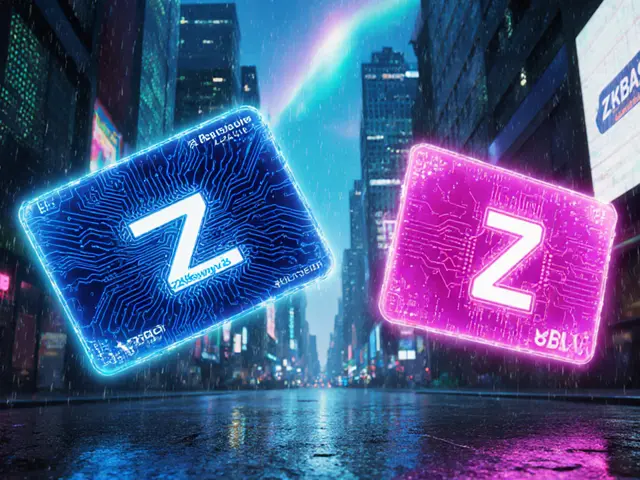Russian P2P Crypto Trading Platform Selector
Top Platforms Overview
| Platform | Ads (24h) | Volume (USD) | Fees | Payment Methods |
|---|
How to Use This Tool
This tool helps you quickly compare key metrics across Russian P2P crypto trading platforms. Adjust the reputation slider to filter platforms based on trustworthiness, and sort by different criteria to find the best fit for your needs.
- Higher ads count often indicates higher liquidity
- Higher volume suggests more active trading
- Lower fees save money on frequent trades
- Ensure payment methods align with your bank/card
P2P cryptocurrency trading in Russia is a decentralized method that lets users swap digital assets directly for Russian rubles (RUB) without going through banks or traditional exchanges. Because of tight banking restrictions and sanctions, this peer‑to‑peer approach has become the go‑to way for Russian crypto enthusiasts to move money in and out of the market.
The rise of P2P crypto trading Russia reflects a market that values speed, privacy, and access to a wide range of coins, but it also brings a set of unique challenges. Below you’ll find a practical guide to the biggest platforms, how a trade actually works, and the risks you should keep on your radar.
Quick Takeaways
- Bybit dominates the Russian P2P scene with the highest ad count and daily volume.
- Payment methods are tied to local cards (Sberbank, T‑Bank) and the SBP fast‑payment system.
- Counterparty and platform risk are the top threats; always check reputation scores above 95%.
- Volatility can turn a seemingly safe RUB‑stablecoin swap into a loss within minutes.
- Use two‑factor authentication and escrow‑protected trades to protect yourself.
How P2P Trading Works on Russian Platforms
- Buy a stablecoin (usually USDT) on the spot market or via a fiat on‑ramp.
- Go to the platform’s P2P marketplace and filter listings for "RUB" and your preferred payment method.
- Select a seller with a high completion rate (≥95%) and click “Buy”. The stablecoin is placed in escrow.
- Transfer RUB to the seller using the indicated method (e.g., Sberbank card, SBP, Mir).
- Once the seller confirms receipt, release the escrow and the stablecoin lands in your wallet.
All major platforms use an automated escrow system that protects both parties, but the speed of release depends on the seller’s verification of the payment.
Leading P2P Platforms in Russia (2025)
Below is a snapshot of the most active platforms as of October 2025. Numbers are 24‑hour statistics pulled from each exchange’s public P2P dashboard.
| Platform | Ads (24h) | Volume (USD) | Typical Fees | RUB Deposit Methods | Key Extras |
|---|---|---|---|---|---|
| Bybit | 3,829 | $27,189,103 | 0.1% taker | Local cards (Sberbank, T‑Bank), Advcash, e‑wallets | Spot, futures, staking, copy‑trading, bots |
| HTX P2P | 1,351 | $7,690,063 | 0.15% taker | Bank transfers, local cards | DeFi hub, token launchpad |
| MEXC | 605 | $2,244,441 | 0% maker / 0.02% taker | Cards, Payeer, SBP, Yandex Money | 500x leverage, daily airdrops |
| Bitget | 445 | $1,885,313 | 0.1% spot, 0.02% maker | Local cards, SBP, e‑wallets | Social trading, VASP license (EU) |
| KuCoin | 400 | $3,208,541 | 0.1% taker | Credit/Debit cards only | KuCoin Earn, futures up to 100x |
| Gate.io | - | - | 0.2% taker | Local cards, SBP, bank transfers | 3,600+ coins, staking pool |

Deep Dive Into the Top Five Platforms
Bybit
Bybit leads the Russian market with a fully Russian interface, 24/7 support, and more than 2,000 listed tokens. Its P2P marketplace shows a reputation score system where traders above 95% are considered trustworthy. Deposit options cover the most common local cards (green = Sberbank, yellow = T‑Bank) and a range of e‑wallets, letting users receive RUB directly into their bank accounts.
HTX P2P
Formerly Huobi, HTX focuses on volume over diversity. It offers lower fees for high‑frequency traders and integrates a DeFi hub for yield farming, which appeals to users looking to put their crypto to work after a P2P swap.
MEXC
MEXC stands out for its 0% maker fee and a massive catalog of altcoins-over 2,800. Russian users love the “Traderfest” zero‑fee events and the ability to fund RUB purchases via Payeer or Yandex Money, both popular among the younger demographic.
Bitget
After securing a VASP license in Bulgaria, Bitget expanded its compliance tools, making it a solid choice for users who worry about regulatory crackdowns. It also offers social‑trading features, enabling newbies to copy the strategies of top Russian futures traders.
KuCoin
KuCoin’s strength lies in a clean UI and a modest fee structure, but its RUB deposit options are limited to credit and debit cards, which can be a blocker for users whose banks restrict crypto‑related card payments.
Key Risks When Trading P2P in Russia
- Counterparty risk: The seller may claim non‑receipt of RUB after releasing crypto. Always check the counterparty’s completion rate and read recent reviews.
- Platform risk: Exchanges can be hit by regulatory actions that freeze accounts or suspend P2P services overnight.
- Payment‑method risk: Russian banks are still scrutinizing crypto‑related transfers; a MIR or SBP payment might be flagged and frozen.
- Price volatility: Between the moment you lock in a price and the moment the seller confirms payment, crypto prices can swing 5‑10% in volatile markets.
- Security risk: Phishing attacks targeting escrow links are common. Verify URLs, enable 2FA, and never share private keys.
Choosing the Right Platform - A Mini Checklist
- Reputation score≥95% for most recent 30‑day period.
- Supported RUB deposit methods that match your bank (Sberbank, T‑Bank, SBP, Payeer).
- Escrow release time - platforms that auto‑release after 15‑30minutes of confirmed payment are safer.
- Fee structure - look for ≤0.15% taker fees for high‑volume traders.
- Compliance tools - KYC level that lets you raise limits without triggering bans.
Future Outlook for Russian P2P Crypto
Regulators continue to tighten AML requirements, but they also recognize the need for a legal on‑ramp for crypto‑savvy citizens. Expect more platforms to integrate the Central Bank’s SBP system as a primary payment rail, and we’ll likely see enhanced dispute‑resolution bots that automatically mediate payment‑confirmation conflicts.
DeFi bridges are being added to native wallets (e.g., Bitget Wallet) so users can stake or farm yields immediately after a P2P swap, gradually blurring the line between “exchange” and “financial services”. For traders, the best strategy remains simple: pick a reputable platform, verify the counterparty, protect the trade with escrow, and stay on top of price moves.

Frequently Asked Questions
Can I use a Russian bank card on non‑Russian exchanges?
Only a handful of global exchanges still accept Russian cards, and most of them flag the transaction as high‑risk. Platforms like Bybit and MEXC explicitly list local cards as payment methods, making them the safest choice.
What happens if the seller claims they never received my RUB?
The escrow will not release the crypto until the seller confirms receipt. If a dispute arises, most platforms open a ticket and require screenshots of the bank transfer. Choose sellers with a high success‑rate to minimise this risk.
Are P2P trades taxable in Russia?
The Russian tax authority treats crypto‑to‑fiat swaps as taxable events. You must report gains on the difference between the stablecoin’s market price at purchase and the RUB you receive.
Which platform has the lowest fees for RUB P2P trades?
MEXC offers 0% maker fees and only 0.02% taker fees, making it the cheapest option for high‑volume traders. Bybit’s 0.1% taker fee is still competitive if you value its broader service suite.
How can I protect myself from phishing links in P2P trades?
Always navigate to the platform directly from a bookmarked URL, enable two‑factor authentication, and double‑check that escrow URLs start with the platform’s official domain. Never click links sent via unsolicited messages.





Comments
13 Comments
Tilly Fluf
Thank you for the comprehensive overview. The structured checklist is particularly helpful for newcomers. Ensuring a reputation score above 95% and using escrow are sound practices. It is also wise to monitor fee structures as they can impact profitability. I wish all traders a safe experience.
Darren R.
Honestly, this entire P2P craze is a moral abyss!!!
Hardik Kanzariya
Great points! I'd add that keeping a small reserve of stablecoins can smooth out the volatility while you wait for escrow release. Also, always double‑check the payment confirmation screenshot before releasing funds. This habit has saved many from nasty disputes. Keep the community informed!
Millsaps Delaine
When one surveys the current tableau of Russian peer‑to‑peer crypto platforms, one cannot help but discern a subtle yet profound stratification of power, liquidity, and regulatory exposure that belies the ostensibly democratic veneer promulgated by these services.
Bybit, heralded in many popular guides, indeed commands a formidable volume, yet its dominance is buttressed not merely by raw advertisement counts but by a sophisticated ecosystem of futures, staking, and algorithmic trading bots that coerce users into an ever‑deepening dependency.
HTX P2P, while ostensibly a second‑tier contender, leverages a lower fee schedule to lure high‑frequency arbitrageurs, thereby cultivating a micro‑market where price discovery is skewed by institutional mechanics rather than retail spontaneity.
MEXC's zero‑maker fee is an alluring siren song, but one must remain vigilant to the hidden costs embedded within withdrawal fees and the occasional slippage that arises when the order book thins during periods of heightened volatility.
Bitget's acquisition of a VASP licence, though commendable from a compliance perspective, introduces an additional layer of KYC scrutiny that may prove antithetical to the very anonymity that many Russian traders prize.
KuCoin's reliance on card‑only deposits, while technically convenient, paradoxically narrows its user base to those whose banks have not yet imposed the sweeping sanctionary restrictions that have crippled other payment corridors.
Gate.io's omission of explicit advertising numbers should not be dismissed as a statistical oversight; rather, it signals a strategic de‑prioritisation of the Russian market in favor of broader Asian expansion.
The overarching risk, however, resides not solely in the platforms themselves but in the intricate lattice of payment methods, each of which is subject to unpredictable interdiction by state regulators and banking consortia.
When a user elects to transfer rubles via the SBP system, they must contend with potential freeze orders that can immobilise assets for days, undermining the liquidity that P2P trading promises.
Moreover, the volatile nature of stablecoin pegs under geopolitical stress can precipitate a de‑peg event, converting a seemingly risk‑free USD‑linked token into a speculative liability within the span of a single transaction.
Escrow mechanisms, while ostensibly protective, are only as robust as the dispute‑resolution frameworks that the exchange enforces, and these frameworks often lack the transparency necessary for users to gauge fairness.
Consequently, a prudent trader ought to maintain meticulous records of every transfer, inclusive of timestamps, screenshots, and bank transaction IDs, lest they be blindsided by an opaque arbitration outcome.
Diversifying across at least two platforms mitigates the systemic risk associated with a unilateral service outage, an eventuality that history has demonstrated is not merely hypothetical.
In addition, integrating on‑chain monitoring tools can provide early warnings of abnormal fee spikes or sudden reductions in advertised ad counts, both of which may herald an imminent crackdown.
Ultimately, the judicious synthesis of platform selection, payment method redundancy, and vigilant risk management constitutes the only viable strategy for sustainable participation in this nascent market.
One would be well advised to revisit these principles routinely, as the regulatory and technological landscape evolves with a rapidity that defies complacency.
Jack Fans
You made some great points, but let me clarifiy a few things. First, Bybit's escrow is actually automated after 15 minutes, not just manual. Second, the SBP system has introduced a new API that reduces freeze times. Also, keep in mind that MEXC's withdrawal fees vary by blockchain. Lastly, diversifiying across platforms can also help you avoid sudden bans. Hope this helps!!!
mark gray
Thanks for the clarification. I’ll keep those tips in mind.
Mark Briggs
meh, another guide.
mannu kumar rajpoot
What they don’t tell you is that these platforms are part of a larger surveillance net feeding data to hidden agencies.
Shanthan Jogavajjala
The systemic infiltration vector operates via AML KYC pipelines, leveraging blockchain analytics heuristics and off‑chain data correlation, effectively creating a feedback loop that nullifies perceived anonymity.
Cindy Hernandez
For anyone just starting, remember to verify the seller’s recent trade history and use the platform’s built‑in chat to confirm payment details before releasing escrow.
Karl Livingston
Imagine the thrill of watching a stablecoin glide across the digital ether, only to land safely in your wallet like a hummingbird finding a flower – that’s the joy of a well‑executed P2P swap!
Chris Hayes
The market’s obsession with fee percentages ignores the bigger picture: user safety and regulatory compliance.
victor white
One suspects the emphasis on fees is a deliberate distraction engineered by entities seeking to keep traders focused on micro‑costs while systemic risks fester unnoticed.
Write a comment